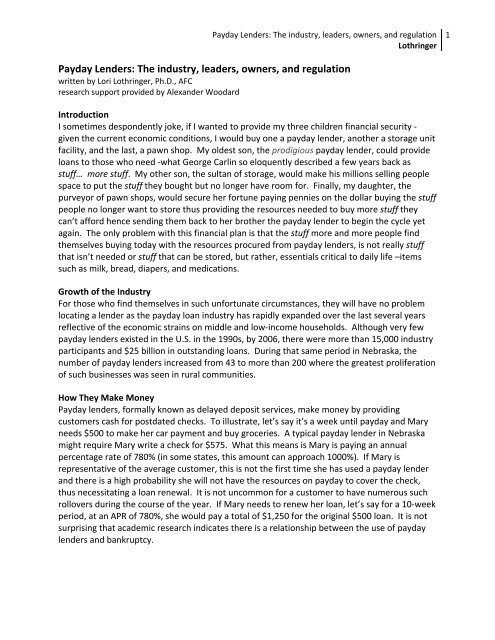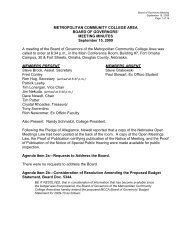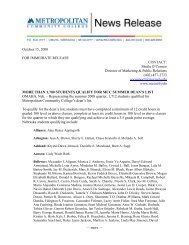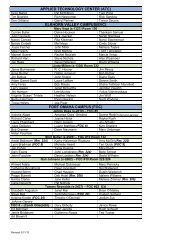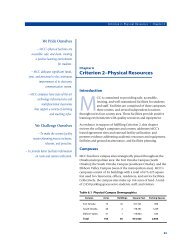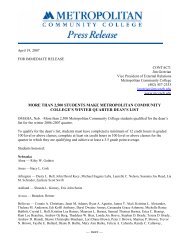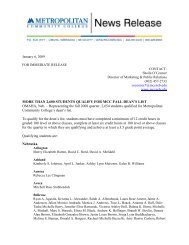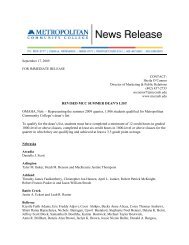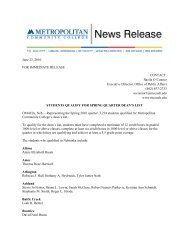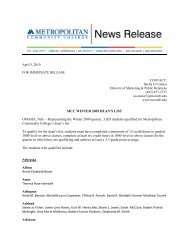Payday Lenders: The industry, leaders, owners, and regulation
Payday Lenders: The industry, leaders, owners, and regulation
Payday Lenders: The industry, leaders, owners, and regulation
You also want an ePaper? Increase the reach of your titles
YUMPU automatically turns print PDFs into web optimized ePapers that Google loves.
<strong>Payday</strong> <strong>Lenders</strong>: <strong>The</strong> <strong>industry</strong>, <strong>leaders</strong>, <strong>owners</strong>, <strong>and</strong> <strong>regulation</strong><br />
Lothringer<br />
<strong>Payday</strong> <strong>Lenders</strong>: <strong>The</strong> <strong>industry</strong>, <strong>leaders</strong>, <strong>owners</strong>, <strong>and</strong> <strong>regulation</strong><br />
written by Lori Lothringer, Ph.D., AFC<br />
research support provided by Alex<strong>and</strong>er Woodard<br />
Introduction<br />
I sometimes despondently joke, if I wanted to provide my three children financial security ‐<br />
given the current economic conditions, I would buy one a payday lender, another a storage unit<br />
facility, <strong>and</strong> the last, a pawn shop. My oldest son, the prodigious payday lender, could provide<br />
loans to those who need ‐what George Carlin so eloquently described a few years back as<br />
stuff… more stuff. My other son, the sultan of storage, would make his millions selling people<br />
space to put the stuff they bought but no longer have room for. Finally, my daughter, the<br />
purveyor of pawn shops, would secure her fortune paying pennies on the dollar buying the stuff<br />
people no longer want to store thus providing the resources needed to buy more stuff they<br />
can’t afford hence sending them back to her brother the payday lender to begin the cycle yet<br />
again. <strong>The</strong> only problem with this financial plan is that the stuff more <strong>and</strong> more people find<br />
themselves buying today with the resources procured from payday lenders, is not really stuff<br />
that isn’t needed or stuff that can be stored, but rather, essentials critical to daily life –items<br />
such as milk, bread, diapers, <strong>and</strong> medications.<br />
Growth of the Industry<br />
For those who find themselves in such unfortunate circumstances, they will have no problem<br />
locating a lender as the payday loan <strong>industry</strong> has rapidly exp<strong>and</strong>ed over the last several years<br />
reflective of the economic strains on middle <strong>and</strong> low‐income households. Although very few<br />
payday lenders existed in the U.S. in the 1990s, by 2006, there were more than 15,000 <strong>industry</strong><br />
participants <strong>and</strong> $25 billion in outst<strong>and</strong>ing loans. During that same period in Nebraska, the<br />
number of payday lenders increased from 43 to more than 200 where the greatest proliferation<br />
of such businesses was seen in rural communities.<br />
How <strong>The</strong>y Make Money<br />
<strong>Payday</strong> lenders, formally known as delayed deposit services, make money by providing<br />
customers cash for postdated checks. To illustrate, let’s say it’s a week until payday <strong>and</strong> Mary<br />
needs $500 to make her car payment <strong>and</strong> buy groceries. A typical payday lender in Nebraska<br />
might require Mary write a check for $575. What this means is Mary is paying an annual<br />
percentage rate of 780% (in some states, this amount can approach 1000%). If Mary is<br />
representative of the average customer, this is not the first time she has used a payday lender<br />
<strong>and</strong> there is a high probability she will not have the resources on payday to cover the check,<br />
thus necessitating a loan renewal. It is not uncommon for a customer to have numerous such<br />
rollovers during the course of the year. If Mary needs to renew her loan, let’s say for a 10‐week<br />
period, at an APR of 780%, she would pay a total of $1,250 for the original $500 loan. It is not<br />
surprising that academic research indicates there is a relationship between the use of payday<br />
lenders <strong>and</strong> bankruptcy.<br />
1
<strong>Payday</strong> <strong>Lenders</strong>: <strong>The</strong> <strong>industry</strong>, <strong>leaders</strong>, <strong>owners</strong>, <strong>and</strong> <strong>regulation</strong><br />
Lothringer<br />
Who are the <strong>Payday</strong> <strong>Lenders</strong>?<br />
Thoughts of the neighborhood payday lender might conjure up images of small‐scale,<br />
independently owned facilities operating out of a low‐rent strip mall where the signs<br />
advertising FAST CASH look h<strong>and</strong>‐made. Don’t be fooled. This is a lucrative <strong>industry</strong> dominated<br />
by large publicly traded companies including Cash America International, Inc. with a net income<br />
(NI) of more than $79 million <strong>and</strong> Advance America, Cash Advance Centers, Inc. with a net<br />
income of approximately $54 million. Other leading <strong>industry</strong> participants include World<br />
Acceptance Corporation (NI ≈ $53 million), EZCORP, Inc. (NI ≈ $52 million), First Cash Financial<br />
Services, Inc. (NI ≈ $35 million), <strong>and</strong> QC Holdings, Inc. (NI ≈ $14 million).<br />
Who are the Executive Leaders?<br />
Similar to other large corporate entities, the <strong>leaders</strong>hip of these organizations is educated <strong>and</strong><br />
credentialed. Many have vast experience in public accounting <strong>and</strong> investment banking <strong>and</strong><br />
hold advanced degrees from prestigious institutions such as Yale. <strong>Payday</strong> lender board<br />
members have served as executives <strong>and</strong> on boards of other well‐known corporations including<br />
RadioShack, Toys “R” Us, <strong>and</strong> Ryan’s Family Steak House as well as non‐profit boards such as<br />
the YMCA. Further, many have significant ties to the health care <strong>industry</strong> with organizations<br />
such as GE Healthcare <strong>and</strong> UnitedHealth Group. <strong>The</strong>ir <strong>leaders</strong>hip experience also includes roles<br />
in government <strong>and</strong> politics, where they possess years of experience in organizations such as the<br />
Federal Deposit Insurance Corporation (FDIC). Examples of high‐level governmental <strong>leaders</strong>hip<br />
roles include William M. Webster (Founder, Director, <strong>and</strong> Chairman of the Board at Advance<br />
America Cash Advance Centers, Inc.) who served as Assistant to the President <strong>and</strong> Chief of Staff<br />
to the U.S. Department of Education during the Clinton administration<br />
Who are the Institutional Investors?<br />
<strong>The</strong> size <strong>and</strong> <strong>owners</strong>hip of the <strong>industry</strong> is both startling <strong>and</strong> unsettling for many. This billion<br />
dollar business counts as its major investors Barclays Global Investors UK Holdings Ltd. who has<br />
approximately $177 million invested in securities associated with payday loan organizations <strong>and</strong><br />
<strong>The</strong> Vanguard Group, Inc. with roughly $115 million of similar <strong>industry</strong> assets. Other large<br />
institutional holders include Thomas W. Smith with over $79 million invested in the <strong>industry</strong>.<br />
Smith is the senior partner of Prescott Investors <strong>and</strong> serves as chairman of the board of the<br />
National Center for Policy Analysis (NCPA) a nonprofit organization whose stated goal is to<br />
develop <strong>and</strong> promote private alternatives to government <strong>regulation</strong> <strong>and</strong> control, solving<br />
problems by relying on the strength of the competitive, entrepreneurial private sector. Banking<br />
organizations, also large institutional <strong>owners</strong> of payday lenders, include Bank of New York<br />
Mellon Corporation with approximately $25 million invested in payday lending interests, JP<br />
Morgan Chase & Company holding about $21 million in such investments, <strong>and</strong> Bank of America<br />
Corporation with roughly $2 million in similar assets. Finally, <strong>and</strong> perhaps most troubling, are<br />
public funds invested in the <strong>industry</strong> such as CALPERS (California‐Public Employees Retirement<br />
System) that holds slightly more than a quarter of a million dollars in public employee<br />
retirement resources in the form of payday lender investments.<br />
2
<strong>Payday</strong> <strong>Lenders</strong>: <strong>The</strong> <strong>industry</strong>, <strong>leaders</strong>, <strong>owners</strong>, <strong>and</strong> <strong>regulation</strong><br />
Lothringer<br />
Who are the real <strong>owners</strong>?<br />
For those readers who consider themselves conscientious investors, those who have avoided<br />
the tobacco <strong>and</strong> gaming stocks <strong>and</strong> instead embraced the eco‐friendly green funds, now might<br />
be a good time to determine if you are in fact an innocent participant in the predatory lending<br />
<strong>industry</strong> via your employer’s 401k or 403b plan. <strong>The</strong> chart below lists the twenty largest mutual<br />
fund holders of what the investment community refers to as consumer finance companies who<br />
offer short‐term small loans to consumers – AKA… payday lenders. Reflective of the<br />
institutional <strong>owners</strong>hip, <strong>The</strong> Vanguard Group, Inc. has the largest number of individual mutual<br />
fund holdings with <strong>owners</strong>hip interests in the payday loan <strong>industry</strong>. Illustrating the dynamics of<br />
diversification, Vanguard has holdings in all of the largest payday loan organizations. Another<br />
disconcerting issue presented in the table is the approximate $8 million in the College Retirement<br />
Equities Fund‐Stock Account TIAA‐CREF has invested in the two largest payday loan organizations,<br />
Cash America International, Inc. <strong>and</strong> Advance America, Cash Advance Centers, Inc. For many in<br />
the academic, medical, cultural, <strong>and</strong> research fields ‐who spend their lives committed to the helping<br />
others while entrusting their retirement security to TIAA‐CREF, this presents an obvious ethical conflict<br />
of interest.<br />
<strong>Payday</strong> Loan Industry: Top 20 Mutual Fund Investors<br />
Fund Shares Value Industry<br />
Holdings<br />
3<br />
Reported<br />
Columbia Acorn Fund 1,545,000 $55,620,000 WRLD 9/30/08<br />
Vanguard Explorer Fund, Inc. 587,686 $38,868,799 QCCO 10/31/08<br />
Oppenheimer Main Street Small Cap Fund 177,300 $29,965,821 WRLD 9/30/08<br />
Vanguard Small‐Cap Index Fund 145,703 $27,256,624 WRLD 9/30/08<br />
IShares Russell 2000 Index Fund 193,870 $23,002,862 WRLD 10/31/08<br />
Columbia Acorn USA Fund 407,900 $14,684,400 WRLD 9/30/08<br />
IShares S&P Small Cap 600 Index Fund 170,845 $13,956,807 WRLD 10/31/08<br />
Harbor Small Cap Value Fund 385,662 $13,640,864 CSH 10/31/08<br />
DFA U.S. Micro Cap Series 177,000 $13,571,709 WRLD 8/31/08<br />
Pacific Advisors Small Cap fund 400,000 $13,250,000 EZPW 9/30/08<br />
Vanguard Total Stock Market Index Fund 186,950 $10,981,762 FCFS 9/30/08<br />
Columbia Fds Ser Tr I‐Columbia Small Cap Core Funds 177,170 $10,596,237 QCCO 9/30/08<br />
Vanguard Strategic Equity Fund 563,426 $10,592,408 EZPW 9/30/08<br />
American Century Small Company Fund 266,565 $9,607,002 CSH 9/30/08<br />
American Beacon Small Cap Value Fund 204,100 $9,466,443 WRLD 11/30/08<br />
AXA Premier VIP Multimanager Small Cap Value Portfolio 330,000 $8,554,500 EZPW 9/30/08<br />
College Retirement Equities Fund‐Stock Account 195,529 $8,139,901 CSH 9/30/08<br />
Bridgeway Funds Inc‐Small Cap Value Fund 396,000 $7,444,800 EZPW 9/30/08<br />
American Century New Opportunities II Fund 360,769 $6,782,457 EZPW 9/30/08<br />
Allianz Funds‐NFJ Small Cap Value Fund 2,230,900 $6,670,391 AEA 9/30/08<br />
AEA: Advance America, Cash Advance Centers Inc. CSH: Cash America International, Inc. EZPW: EZCORP Inc.<br />
QCCO: QC HOLDINGS, INC. WRLD: WORLD ACCEPTANCE C<br />
Source: Yahoo Finance
<strong>Payday</strong> <strong>Lenders</strong>: <strong>The</strong> <strong>industry</strong>, <strong>leaders</strong>, <strong>owners</strong>, <strong>and</strong> <strong>regulation</strong><br />
Lothringer<br />
<strong>The</strong> Movement to Regulate<br />
It is estimated that more than 10 million American households utilize payday lenders each<br />
year. Considering the previously mentioned exorbitant APRs, <strong>and</strong> evidence that some payday<br />
lenders are capturing Social Security direct‐deposit payments directly from beneficiaries, it is<br />
easy to underst<strong>and</strong> why states such as Arkansas, New York <strong>and</strong> South Carolina have passed<br />
stringent legislation regulating payday lending activities including the institution of strict usury<br />
laws limiting the amount of interest payday lenders can charge customers. In Nebraska, both<br />
Senator McGill (LB431) <strong>and</strong> Senator Nantkes (LB293) have introduced bills that institute stricter<br />
<strong>regulation</strong>s on the payday loan <strong>industry</strong>. Before advancing such change, the costs <strong>and</strong><br />
consequences of such legislation should be considered.<br />
Potential Consequences of Proposed Regulation<br />
First, if Nebraska were to successfully eliminate payday lending activities, where would the at‐<br />
risk communities who frequent these facilities go to acquire much‐needed cash resources?<br />
Research conducted last year by academicians from the University of Missouri <strong>and</strong> George<br />
Washington University suggests middle <strong>and</strong> low‐income households –those with few choices,<br />
may be negatively impacted by the complete elimination of the <strong>industry</strong>. At a time when food‐<br />
bank provisions are stretched, without viable alternatives in place such as low‐interest short‐<br />
term consumer loans provided by lending institutions, families could go hungry. Second, are<br />
we prepared to fight the battle? In states where the citizen coalitions have taken on the<br />
payday lenders, the <strong>industry</strong> has fought back. In Ohio <strong>and</strong> Arizona last year, payday lender<br />
organizations spent almost $30 million to defeat ballot initiatives limiting the <strong>industry</strong>. Further,<br />
Rent‐A‐Center indicated it would eliminate $500,000 in charitable funding to a local food bank<br />
unless the Ohio Coalition for Responsible Lending pulled its support of the legislation. Through<br />
community actions <strong>and</strong> voter awareness, the initiatives passed in both states.<br />
Effective elimination of predatory lending activities in Nebraska should be preceded by a<br />
comprehensive underst<strong>and</strong>ing of the <strong>industry</strong> including <strong>owners</strong>hip <strong>and</strong> investment interests.<br />
Further, safety nets should be established for those households who may be immediately <strong>and</strong><br />
negatively impacted by the application of the proposed legislation. One impressive example of<br />
an alternative lending program is the <strong>Payday</strong> Alternative Loan (Salva Vida/Lifesaver Loan)<br />
Program established by the Mission SF Federal Credit Union in San Francisco. Committed to<br />
serving its members who are primarily Latino families earning incomes of less than $20,000,<br />
this credit union extends loans up to $500 at a rate of 18%. Mr. Salvador Duran, Manager <strong>and</strong><br />
CEO of Mission SF explains, “We provide emergency financial resources to our members – but<br />
we are not just h<strong>and</strong>ing out checks. We use this as an opportunity to provide financial literacy<br />
education <strong>and</strong> counseling.” Through the committed efforts of Mr. Duran, <strong>and</strong> other local<br />
<strong>leaders</strong>, families are being served <strong>and</strong> San Francisco is no longer issuing licenses to payday<br />
lenders who want to set up shop in the city.<br />
4
<strong>Payday</strong> <strong>Lenders</strong>: <strong>The</strong> <strong>industry</strong>, <strong>leaders</strong>, <strong>owners</strong>, <strong>and</strong> <strong>regulation</strong><br />
Lothringer<br />
Conclusion<br />
Over the last two decades, the exp<strong>and</strong>ing payday loan <strong>industry</strong> has enjoyed significant profits<br />
through the process of providing customers short‐term high‐interest rate loans. This lucrative<br />
<strong>industry</strong> is dominated by large publicly traded companies lead by highly experienced, educated<br />
<strong>and</strong> credentialed individuals whose resumes include high‐profile corporate <strong>and</strong> government<br />
<strong>leaders</strong>hip positions. Major institutional investors include Barclays Global Investors UK<br />
Holdings Ltd., <strong>The</strong> Vanguard Group, Inc., the Bank of New York Mellon Corporation, JP Morgan<br />
Chase & Company, <strong>and</strong> the Bank of America Corporation. <strong>The</strong> real <strong>owners</strong>, many unassuming<br />
individual investors, who ‐through their employers 401k <strong>and</strong> 403b retirement funds, are holding<br />
various mutual funds with <strong>owners</strong>hip interests in the payday loan <strong>industry</strong>. Due to public<br />
concern <strong>and</strong> pressure, many states have moved to regulate the <strong>industry</strong> limiting the interest<br />
<strong>and</strong> other terms specific to lending practices. Given the social <strong>and</strong> economic consequences of<br />
payday loans, there is an obvious need for increased <strong>regulation</strong>; however, before instituting<br />
such change, states should carefully consider the costs <strong>and</strong> consequences of such legislation.<br />
RESOURCES:<br />
<strong>Payday</strong> loan legislation in Nebraska:<br />
LB293 (Adopt the Short‐Term <strong>Lenders</strong> Act <strong>and</strong> eliminate the Delayed Deposit Services<br />
Licensing Act):<br />
http://www.nebraskalegislature.gov/FloorDocs/Current/PDF/Intro/LB293.pdf<br />
LB431 (Change Delayed Deposit Services Licensing Act provisions):<br />
http://www.nebraskalegislature.gov/FloorDocs/Current/PDF/Intro/LB431.pdf<br />
<strong>Payday</strong> loans in Nebraska: http://www.ndbf.ne.gov/dds/index.shtml<br />
<strong>Payday</strong> loan cost calculator: http://www.paydayloaninfo.org/calc.cfm<br />
<strong>Payday</strong> Alternative Loan Effort (Salva Vida/Lifesaver Loan):<br />
http://www.mission.coop/ASP/aboutus.asp#j<br />
5


